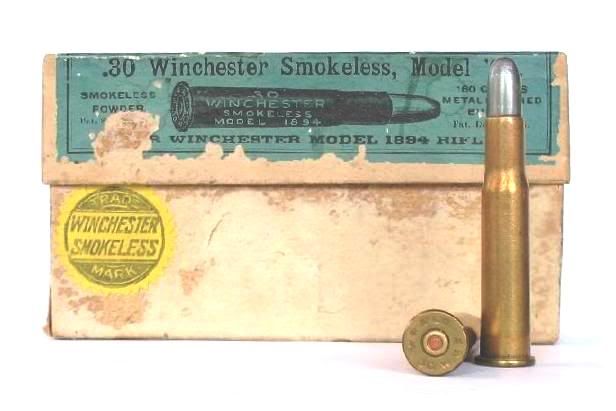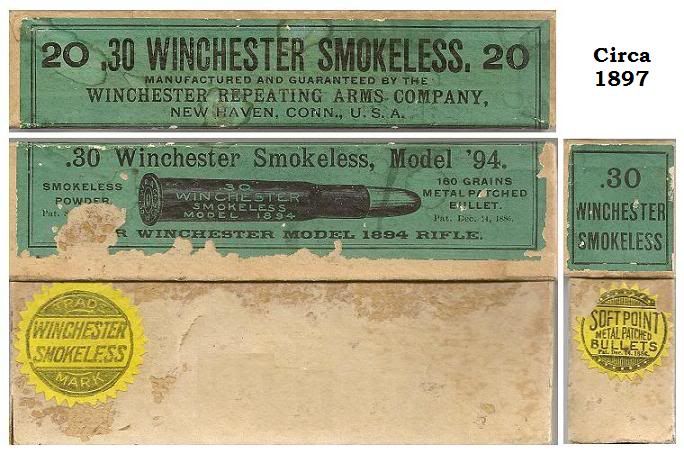A friend gave me a partial box of .30 WCF the other day. Other than a couple of odd head stamps to the box, most were WRACO 30 WCF metal cased soft points with the neat "W" marked protected primers. The box and cartridges are in tough shape. From what I could make out on the label it appears to be the "Variety 3 (Ca. 1903-05)" box, Pg. 174 Giles and Shuey.
http://s1226.photobucket.com/user/hurint/media/DSCN4242a_zpse8b8734f.jpg.html
[Image Can Not Be Found]
Quite a lot of corrosion on the cartridges. Looking them over I culled out seven split case necks and decided to re-use the bullets. My inertia puller tends to separate this type of bullet when I tried this once before on a better condition case, but on these with split necks it only took a couple of taps. Weighed out the charges and found them to be 25 to 25.1 grains powder.
http://s1226.photobucket.com/user/hurint/media/DSCN4245a_zps43462e9e.jpg.html
[Image Can Not Be Found]
Bullets weighed in at 170 grains. Looking through the 1903 WRA catalog, they list .30 WCF Smokeless as 160 grain bullet at 1885 fps. My next catalog is 1905 where .30 WCF is up to a 170 grain bullet at 1960 fps. If these rounds were native to the box it looks like they could have been the 1905 cataloged load. If you look close at the standing bullet on the left, you can make out a "W" on the bullet just above the cannelure.
http://s1226.photobucket.com/user/hurint/media/DSCN4247edited_zpsc18a55c7.jpg.html
[Image Can Not Be Found]
I loaded the bullets in some once fired Winchester brass with WLR primers and some Winchester 748 powder with a starting load form an older Hornady manual.
http://s1226.photobucket.com/user/hurint/media/DSCN4250edited_zps637279e4.jpg.html
[Image Can Not Be Found]
Took my 1894 Rifle out in the woods later in the day and plinked a little. Also had some 150 grain loads in the other pants pocket, Hornady 150 grain bullet and BL-C(2) powder. I used an old cow skull for a target. I put a couple of the old Winchester bullets through it length ways and was impressed with the size of the hole. Both powders burn completely in the loads I’m using and leave the bore pretty clean. I decided to keep the five old bullet cartridges I have left with the intention of hunting with them someday.
Brad
Kirk
Here are some better pictures I hope.
http://s1226.photobucket.com/user/hurint/media/DSCN4317_zps837a92a8.jpg.html
[Image Can Not Be Found]
http://s1226.photobucket.com/user/hurint/media/DSCN4284_zps3a4948af.jpg.html
[Image Can Not Be Found]
I’m surely no expert. To me they look original. Maybe you all know for some things to look for I don’t. If they are reloaded I would think they were done quite awhile ago. I did see some evidence on a brass and bullet that they may have been loaded in a magazine or chambered before. Normally I don’t clean these things, especially ammo, but the green was pretty thick on these so I wiped it off.
I do believe it’s very possible to get split case necks without reloading. I did some reading awhile ago on the cartridge collecting website after finding some in other boxes, early REM-UMC ammo in my experience. I remember the reasons for split necks weren’t always very clear. Some thoughts were environmental changes related to storage and excessive handling or cleaning could cause split necks. Apparently the brass is going through minor changes itself over time. Any collector type boxes I have I try not to handle beyond looking at the head stamps and a few of the cartridges. These were in a heavily soaked box and had lots of crud/corrosion buildup as I mentioned. Figured some of the bullets would be a good experiment at least.
Brad
Interesting concerning the split cartridges. I’ve seen almost every 30-40 military load with a split neck but can’t recall seeing commercial Model 1894 cartridges with a split neck. I too wonder if the 170 grain bullets were actually for the Krag and were reloaded into commercial cases.
Good observation 38-55!
WACA Life Benefactor Member
NRA Life Member
Chris
Those protected primers are also in this 32WS box that I think is 1906-10.
http://s1226.photobucket.com/user/hurint/media/wacaforum1.jpg.html
[Image Can Not Be Found]
According to the Giles and Shuey book the protected primer patent date is Sept. 9, 1884. I’m not sure when they stop.
The box in my original post looks to be of the time period of the ammo to me, and Winchester cataloged the 170 grain metal patched soft point for a long time after the "Variety 3 (Ca 1903-05)" box. I guess it’s possible somebody bought primers and brass and loaded Winchester bullets for the .30-30 in them outside the factory at some point? Or it’s factory.
I thought it was interesting to examine the charge weight. Maybe somebody with powder knowledge can identify it.
Here’s a link to some cartridge collecting guidelines and they discuss split necks about half way down in the reading:
http://www.cartridgecollectors.org/?page=guide
Brad
The powder in the original cartridges is Lightning No. 2. Burning rate is similar to today’s 4198. I have delighted in dissecting some old .30 W.C.F. cartridges and loading the components (bullet and powder) into modern cases and firing them. Still plenty of power from 100 yr. old cartridges. 😀
I have also found split necks in some old factory ammunition.
w30wcf
I have seen many split necks on 60 year old (factory "new" )Dominion or Imperial (Canadian CIL ) bottleneck Factory cartridges. I think the brass they used was too brittle
You cannot reload most of their old brass without problems. (but I never tried to anneal any first ) . Tho their thin brass 44-40 and 38-40 are better and I have reloaded them

Cartridge brass will harden and become brittle with age. I would not under
any circumstances fire old ammo in any of my firearms. Some years ago
a friend got some old 300 Savage ammo at a gun show. Savage headstamp. The second shot the case split lengthwise right through the
primer pocket. It didn’t damage the action (99 savage) but blew the forearm off and blew both side panels off the buttstock. Made a believer out of me.
B
The .30 WCF box is beat up and grimed over some. It has the markings of the "Variety 2" box from 1903, but I believe I can make out the "7" where "170 GRAINS" is on the label and it also still has the "sunburst" label used before the [color=red:c55c524624]W[/color:c55c524624]. According to the book it would be a Variety 3 box 1903-05. Of course, the ammunition might not be what was originally in the box.
The 32WS box says "1-7" and looks exactly like the one in the book dated 1-7, has the protected primers shown on the label. I guess I didn’t think about looking at the date when I wrote: "I think is 1906-10".
Brad
“If you look close at the standing bullet on the left, you can make out a "W" on the bullet just above the cannelure.”
The trademark “W” was stamped on the bullets beginning in 1902. It was first used on the .30 W.C.F. bullets. Others soon followed. This practice was discontinued in 1932.
“According to the Giles and Shuey book the protected primer patent date is Sept. 9, 1884. I’m not sure when they stop.”
The Sept. 9, 1884 is the patent date for smokeless powder. The protected primers were first introduced in 1895 and used initially in the .30 WCF & .25-35. They were discontinued in the early 1920’s and replaced by the ‘NF” (Non Fulminate) series. Unfortunately, the NF primers were corrosive. The Staynless series replaced them in 1930 (Thankfully!).
“The box in my original post looks to be of the time period of the ammo to me, and Winchester cataloged the 170 grain metal patched soft point for a long time after the "Variety 3 (Ca 1903-05)" box. I guess it’s possible somebody bought primers and brass and loaded Winchester bullets for the .30-30 in them outside the factory at some point? Or it’s factory.”
I am fairly certain that the cartridges are native to the box. Winchester really discouraged the reloading of cartridges at that time.
“I thought it was interesting to examine the charge weight. Maybe somebody with powder knowledge can identify it.”
The powder is Lightning No. 2. It was introduced by DuPont in 1903 and discontinued in 1929.
references:
W.R.A. Headstamped Cartridges And Their Variations (Dan Schuey)
Complete Guide To Handloading (Philip Sharpe)
w30wcf
BJREBUCK said
Cartridge brass will harden and become brittle with age. I would not under
any circumstances fire old ammo in any of my firearms. Some years ago
a friend got some old 300 Savage ammo at a gun show. Savage headstamp. The second shot the case split lengthwise right through the
primer pocket. It didn’t damage the action (99 savage) but blew the forearm off and blew both side panels off the buttstock. Made a believer out of me.
B
I would bet that case had previously been fired with a mercuric primer then reloaded. Mercury attacks brass, making it brittle. Not good!
I have used W.R.A. CO. .30 W.C.F. & W.R.A. CO. .44 W.C.F. headstamped brass in reloads with nary a problem. These were from virgin factory cartridges from which I removed the bullet & powder and primers. The primers were discarded. I then annealed the cases. My reason for doing so was to have cases that matched the rifle’s chambering marked on the barrel.
IMPORTANT: If one is going to use older brass, use only virgin cases to be sure that they have not been previously fired with mercuric primers.
w30wcf
Regarding split necks….
In looking through the boxes of my .30 W.C.F Winchester cartridges it appears that pretty much all have split necks up until 1910 or so. Between 1910 to around 1920 about 50% had split necks. After that I did not find many with split necks. After 1930, none were found.
Interestingly, in the couple of UMC .30-30 boxes I have (pre 1911) there were no split necks and in the REM-UMC .30-30 boxes (post 1911) none with split necks were found.
So the properties of material in each particular lot of brass has an affect.
All of the cartridges in this 1897 box are in pristine condition and all have split necks.
w30wcf
I have some 44-40 Headstamped DCC (just pre-WW 2 ?) this was the Canadian CIL . The cartridge headstamps were changed to Dominion just after WW 2 , I believe. I have shot the D.C.C. factory cartridges in 44-40 , 38-40, and 32-20 in the past with good results . and later reloaded them OK These dont have any split necks like ive seen on new old stock Dominion 32 spcl, 30-40 ,25-20 ,and other thicker brass Dominion 50’s cartridges.
Can some one tell me approx what year all the American ammo companies switched over to non-corrosive primers , and also non- balloon head cases?

1 Guest(s)


 Log In
Log In Members
Members Home
Home

 Add Reply
Add Reply Add Topic
Add Topic
 Offline
Offline







